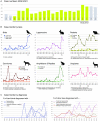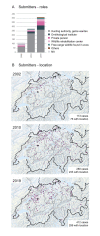Analysis of a European general wildlife health surveillance program: Chances, challenges and recommendations
- PMID: 38771857
- PMCID: PMC11108157
- DOI: 10.1371/journal.pone.0301438
Analysis of a European general wildlife health surveillance program: Chances, challenges and recommendations
Abstract
In a One Health perspective general wildlife health surveillance (GWHS) gains importance worldwide, as pathogen transmission among wildlife, domestic animals and humans raises health, conservation and economic concerns. However, GWHS programs operate in the face of legal, geographical, financial, or administrative challenges. The present study uses a multi-tiered approach to understand the current characteristics, strengths and gaps of a European GWHS that operates in a fragmented legislative and multi-stakeholder environment. The aim is to support the implementation or improvement of other GWHS systems by managers, surveillance experts, and administrations. To assess the current state of wildlife health investigations and trends within the GWHS, we retrospectively analyzed 20 years of wildlife diagnostic data to explore alterations in annual case numbers, diagnosed diseases, and submitter types, conducted an online survey and phone interviews with official field partners (hunting administrators, game wardens and hunters) to assess their case submission criteria as well as their needs for post-mortem investigations, and performed in-house time estimations of post-mortem investigations to conduct a time-per-task analysis. Firstly, we found that infectious disease dynamics, the level of public awareness for specific diseases, research activities and increasing population sizes of in depth-monitored protected species, together with biogeographical and political boundaries all impacted case numbers and can present unexpected challenges to a GWHS. Secondly, we found that even a seemingly comprehensive GWHS can feature pronounced information gaps, with underrepresentation of common or easily recognizable diseases, blind spots in non-hunted species and only a fraction of discovered carcasses being submitted. Thirdly, we found that substantial amounts of wildlife health data may be available at local hunting administrations or disease specialist centers, but outside the reach of the GWHS and its processes. In conclusion, we recommend that fragmented and federalist GWHS programs like the one addressed require a central, consistent and accessible collection of wildlife health data. Also, considering the growing role of citizen observers in environmental research, we recommend using online reporting systems to harness decentrally available information and fill wildlife health information gaps.
Copyright: © 2024 Heiderich et al. This is an open access article distributed under the terms of the Creative Commons Attribution License, which permits unrestricted use, distribution, and reproduction in any medium, provided the original author and source are credited.
Conflict of interest statement
The authors have declared that no competing interests exist.
Figures





Similar articles
-
Capacity building efforts and perceptions for wildlife surveillance to detect zoonotic pathogens: comparing stakeholder perspectives.BMC Public Health. 2014 Jul 4;14:684. doi: 10.1186/1471-2458-14-684. BMC Public Health. 2014. PMID: 24996851 Free PMC article.
-
Wildlife uses and hunting patterns in rural communities of the Yucatan Peninsula, Mexico.J Ethnobiol Ethnomed. 2012 Oct 2;8:38. doi: 10.1186/1746-4269-8-38. J Ethnobiol Ethnomed. 2012. PMID: 23031274 Free PMC article.
-
WILDbase: towards a common database to improve wildlife disease surveillance in Europe.Euro Surveill. 2024 Jun;29(25):2300617. doi: 10.2807/1560-7917.ES.2024.29.25.2300617. Euro Surveill. 2024. PMID: 38904114 Free PMC article.
-
RECENT CHANGES IN INFECTIOUS DISEASES IN EUROPEAN WILDLIFE.J Wildl Dis. 2019 Jan;55(1):3-43. doi: 10.7589/2017-07-172. Epub 2018 Oct 4. J Wildl Dis. 2019. PMID: 30284963 Review.
-
Is there a due diligence standard for wildlife disease surveillance? A Canadian case study.Can Vet J. 2019 Aug;60(8):841-847. Can Vet J. 2019. PMID: 31391600 Free PMC article. Review.
References
-
- Gortázar C, Ferroglio E, Höfle U, Frölich K, Vicente J. Diseases shared between wildlife and livestock: a European perspective. Eur J Wildl Res. 2007;53: 241. doi: 10.1007/s10344-007-0098-y - DOI

